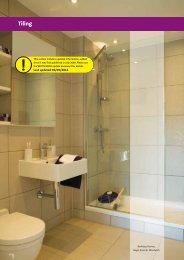SITE BOOK - Plaster systems - British Gypsum
SITE BOOK - Plaster systems - British Gypsum
SITE BOOK - Plaster systems - British Gypsum
Create successful ePaper yourself
Turn your PDF publications into a flip-book with our unique Google optimized e-Paper software.
Technical support: T 0844 800 1991 F 0844 561 8816 E bgtechnical.enquiries@bpb.com<strong>Plaster</strong> <strong>systems</strong>Metal lath• Using Thistle Bonding Coat, apply apricking-up coat, forcing it through themetal lath in order to provide a good keyto the background.• Wire scratch the surface of the prickingupcoat to provide a good key for thefloating coat.• Allow to set but not dry, before applyinga floating coat.Floating coats should be applied ata coat thickness not exceeding 25mm, anddeep wire-scratched between each coat.• Rule the final floating coat to an evensurface and lightly scratch to form a keyfor Thistle Multi-Finish or ThistleDurafinish.• Apply finish plaster once undercoat isset but not dry.• Thistle Durafinish requires ThistleGypPrime to reduce the suction. A mix of5 parts water to 1 part Thistle GypPrimeshould be applied to the undercoat plasterand left to fully dry prior to the applicationof Thistle Durafinish.<strong>Plaster</strong>board (except skimming)Where Thistle Bonding Coat and finishplaster are applied to plasterboards,Gyproc Joint Tape should be used toreinforce joints and angles.• Pre-fill any gap between boardsexceeding 3mm with finish plaster andspread along each joint.• Press Gyproc Joint Tape firmly into thefinish plaster, and immediately cover witha further application.• Allow the joints to stiffen, but not dry,before applying undercoat plaster.9425





